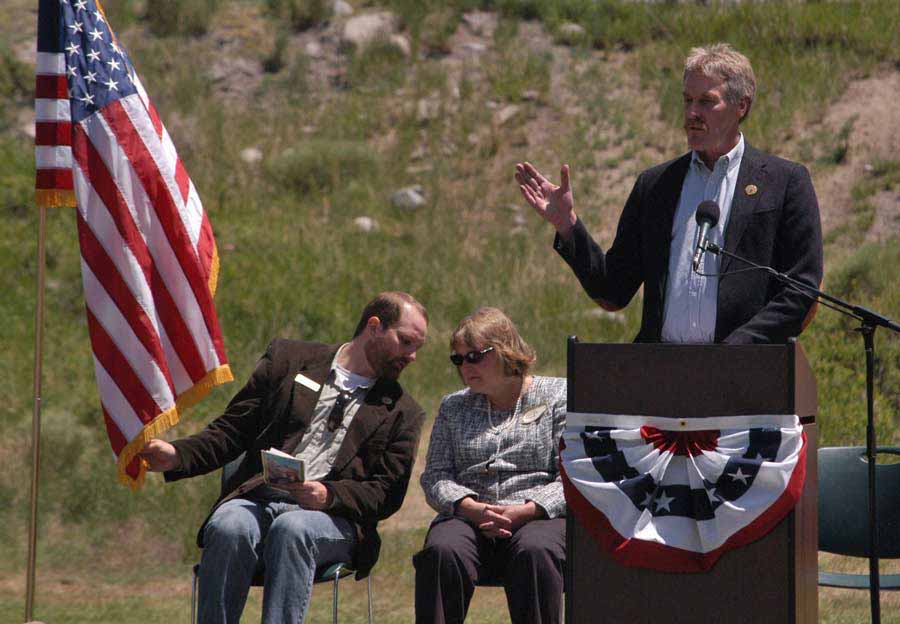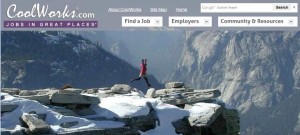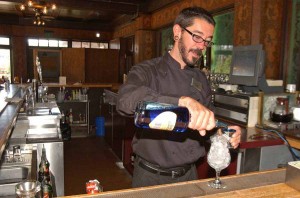
Bill Berg speaks during the Gardiner Gateway Project launch in Gardiner, Mont., sharing the stage with Daniel Bierschwale, president of the Gardiner Chamber of Commerce and Clara Conner, division engineer for Western Federal Lands Highway Division. (Yellowstone Gate/Ruffin Prevost - click to enlarge)
By Ruffin Prevost
GARDINER, MONT. — Bill Berg first came to Yellowstone National Park in 1972 to take a summer job pumping gas. You’ll still find him at Yellowstone’s doorstep, and he’s still all about finding jobs in the park. But four decades later, Berg has become the king of “jobs in great places,” matching workers with employers in some of the most beautiful and inspiring spots in America.
Berg owns and operates CoolWorks.com, an online job placement portal and social media hub that specializes in finding seasonal and year-round workers to toil at national parks, dude ranches, ski areas and other similar venues.
“We link to think at CoolWorks, we change lives one dishwasher at a time,” Berg said last month during a telephone interview from the porch of his Gardiner office, overlooking the Yellowstone River.

The CoolWorks website connects workers and employers for jobs at national parks, dude ranches, ski areas and similar venues.
Launched in November 1995 — a time when job-hunting on the Internet was equal parts novel and obscure — CoolWorks quickly found a niche. Early adopter college students with Internet access were looking for summer jobs, and employers were ready to ditch the old routine of shuffling paperwork through the U.S. mail.
“It was a lot of licking, sticking, stamping, shuffling and stapling,” Berg recalls, “along with a lot of smiling and dialing.”
The speed and efficiency of Internet job recruiting was an obvious improvement, but it seemed especially well-suited to filling the seasonal and far-flung jobs that employers had a tough time finding staffers for. Businesses pay CoolWorks to post job listings, and prospective workers set up free accounts to help them review jobs and connect with employers.
The White House took notice of CoolWorks earlier this year when it included the company among 10 online job listing sites as part of a national public-private partnership aimed at finding summer work for young people, an effort coordinated by the Department of Labor.
Berg also took center stage in Gardiner earlier this month when he helped lead the festivities for the launch of the Gardiner Gateway Project, an ambitious partnership that aims to reconfigure Yellowstone’s North Gate and make numerous improvements in Gardiner aimed at better serving park visitors.

Bill Berg gestures toward the Roosevelt Arch behind him during the Gardiner Gateway Project launch in Gardiner, Mont. (Yellowstone Gate/Ruffin Prevost - click to enlarge)
First trip under the arch
During the Gardiner Gateway Project launch, Berg recalled how it was almost exactly 40 years since his first trip under the Roosevelt Arch, when he arrived to pump gas for the summer in 1972. Now, as president of the Greater Gardiner Community Council, Berg was standing in front of the arch, introducing the governor of Montana and the superintendent of Yellowstone.
He reminded the crowd that many people who end up making their mark in Yellowstone country started out in a seemingly random job doing seasonal work in an unglamorous position.
“Some of those jobs are great, and some are washing dishes or pumping gas,” he said by telephone in May. “But every one of those jobs can be an entry point to something more.”
They are also a chance for young people who have grown up in a city with little connection to the outdoors to discover a wider world, Berg said.
“Even if they just spend one sumer at Denali or the Grand Canyon, they’re liable to get a completely different and maybe life-changing perspective on the natural world,” he said.
But becoming the go-to site for people seeking those life-changing outdoors jobs hasn’t always been easy. Building CoolWorks into a successful, five-person business has required keeping the company lean and nimble, Berg said.
During the late 1990s, almost any Internet-related business seemed like a sure bet, and investors raced to fund schemes like selling pet food online or creating web portals for urban snack and coffee delivery services. Berg had his share of suitors interested in CoolWorks, but he choose to stay small and remain focused on his niche.
When the dotcom bubble burst in 2000, dozens of seemingly solid Internet startups went belly up, saddled with debt and unable to find continued funding. CoolWorks tightened up operations and managed to keep all of its workers employed through the lean times.
“I think it was maybe just dumb luck and being Midwestern cheap that I didn’t leverage the whole thing,” Berg joked.
Staying competitive
But surviving in the constantly evolving Internet landscape has meant refocusing on what makes CoolWorks unique as competitors push to catch up, and employers set up their own online recruitment sites. It’s easier than ever for workers and employers to connect directly online, which is a threat to the traditional role CoolWorks has played in the market.

Topher Reimers tends bar at the Bear Pit in the Old Faithful Inn in Yellowstone National Park. Reimers had worked for six years in the park when this photo was taken in June 2006. (Ruffin Prevost/Yellowstone Gate file photo)
“We can’t take our business for granted, so we try hard to stay relevant,” Berg said.
The main way CoolWorks has evolved in recent years has been through social media networking and by setting up an in-house sharing and networking platform that allows workers to exchange information about jobs, destinations and even employers.
Experienced workers looking for a summer job at a national park or a winter gig at a ski resort can post questions and exchange information with others who have already worked there. That makes CoolWorks a valuable place where applicants know they can get unfiltered, first-hand information that can make the difference between blindly entering an unpleasant workplace and being informed enough to find a dream job in paradise.
For those looking to get hired into a prime gig at a choice spot — a tour guide in Yellowstone, for instance — Berg advises applying early. Some workers apply as early as November for a summer job the following year, and spots start filling up by January, he said.
For first-timers, Berg advises a little self-scrutiny.
“Pick your location carefully based on what you know you can handle,” he said. “A fly-in lodge in Alaska or summer in the south pole is a lot different than a ranch 10 miles outside of Cody (Wyoming). If you think the end-of-the-road factor isn’t for you, don’t go quite so remote.”
Finally, workers should be prepared to stay at their posts through what may be a long, challenging stretch that isn’t always what they imagined or hoped for.
“They have to suck it up and work it through,” Berg said. “After all, they’re getting to live in a place that other people have to pay dearly for just to visit.”
Contact Ruffin Prevost at 307-213-9818 or ruffin@yellowstonegate.com.
